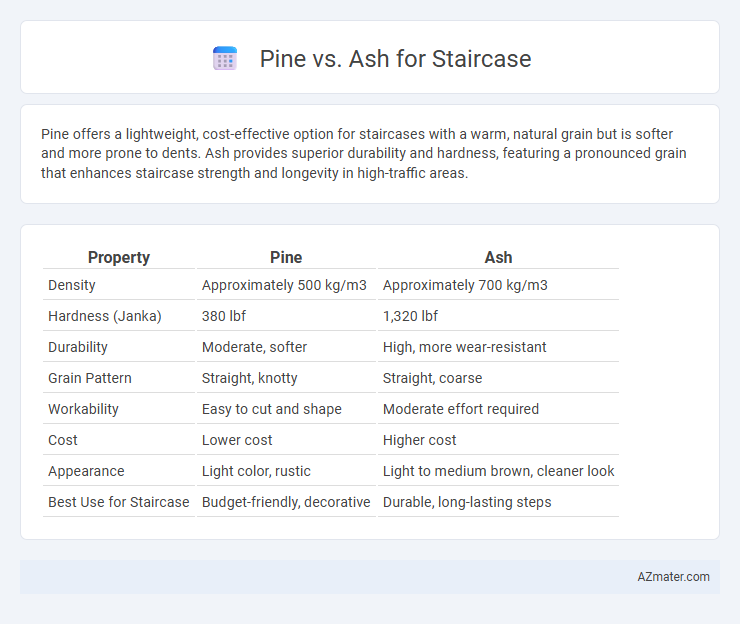Pine offers a lightweight, cost-effective option for staircases with a warm, natural grain but is softer and more prone to dents. Ash provides superior durability and hardness, featuring a pronounced grain that enhances staircase strength and longevity in high-traffic areas.
Table of Comparison
| Property | Pine | Ash |
|---|---|---|
| Density | Approximately 500 kg/m3 | Approximately 700 kg/m3 |
| Hardness (Janka) | 380 lbf | 1,320 lbf |
| Durability | Moderate, softer | High, more wear-resistant |
| Grain Pattern | Straight, knotty | Straight, coarse |
| Workability | Easy to cut and shape | Moderate effort required |
| Cost | Lower cost | Higher cost |
| Appearance | Light color, rustic | Light to medium brown, cleaner look |
| Best Use for Staircase | Budget-friendly, decorative | Durable, long-lasting steps |
Introduction to Pine and Ash for Staircases
Pine and ash are commonly used hardwoods in staircase construction, each offering distinct characteristics that influence durability and aesthetic appeal. Pine, a softwood with a light color and fine grain, is favored for its affordability and ease of workability, making it suitable for painted or stained finishes. Ash, a harder and denser hardwood, stands out for its strength, shock resistance, and attractive grain patterns, often preferred for visible, natural wood staircases requiring enhanced durability.
Wood Characteristics: Pine vs Ash
Pine wood is softer, lighter, and more prone to dents and scratches compared to ash, making it ideal for decorative staircases with low foot traffic. Ash is a hardwood known for its strength, density, and excellent shock resistance, providing superior durability and wear resistance for high-traffic staircases. Ash's distinct grain pattern and smooth finish add a refined aesthetic appeal, whereas pine offers a more rustic look with visible knots and a lighter color palette.
Durability and Strength Comparison
Ash wood offers superior durability and strength compared to pine, making it a preferred choice for staircases that require long-lasting performance and resistance to wear. Pine is softer and more prone to dents and scratches, which may reduce its lifespan in high-traffic areas. Ash's dense grain structure provides enhanced load-bearing capacity, ensuring staircases maintain structural integrity over time.
Aesthetic Appeal: Grain and Color Differences
Pine features a light, creamy color with a soft, uniform grain that offers a rustic and cozy aesthetic ideal for traditional or country-style staircases. Ash presents a more pronounced grain pattern with contrasting light and dark streaks, creating a dynamic texture and a modern, elegant appearance suitable for contemporary designs. The warm honey tones of pine enhance brightness in staircases, while ash's natural contrast adds depth and visual interest to architectural elements.
Cost Analysis: Pine vs Ash Staircases
Pine staircases typically cost less than ash due to the wood's faster growth rate and greater availability, making pine an economical choice for budget-conscious projects. Ash staircases, while pricier, offer superior durability and a higher resistance to wear, which can translate to lower long-term maintenance expenses. Cost analysis between pine and ash staircases hinges on initial budget constraints versus long-term value, with pine favored for affordability and ash for longevity.
Workability and Installation Considerations
Pine offers superior workability due to its softness, making it easier to cut, shape, and sand during staircase installation, which reduces labor time and tool wear. Ash, being harder and denser, requires more effort and specialized tools for cutting and drilling but provides enhanced durability and resistance to dents. Installation of pine staircases is more straightforward for DIY projects, while ash staircases benefit from professional expertise to manage their rigidity and achieve precise fitting.
Maintenance and Longevity of Each Wood Type
Pine staircases require more frequent maintenance due to their softer wood, which is prone to dents and scratches, demanding regular sanding and resealing to maintain appearance. Ash wood offers superior durability and longevity with higher density and resistance to wear, reducing the need for extensive upkeep over time. Choosing ash for staircases ensures a longer-lasting surface that withstands heavy foot traffic with minimal maintenance.
Environmental Impact and Sustainability
Pine stairs have a lower environmental impact due to faster growth rates and carbon sequestration efficiency, making pine a more renewable resource compared to ash, which is slower-growing with longer maturation periods. Ash wood is often sourced from managed forests, but its extraction may contribute to habitat disruption and biodiversity loss due to the removal of older trees. Choosing FSC-certified pine or reclaimed ash enhances sustainability by promoting responsible forestry practices and reducing waste in staircase construction.
Best Applications: When to Choose Pine or Ash
Pine is ideal for staircases in budget-conscious projects and rustic or country-style interiors due to its softness and ease of sanding and staining. Ash, known for its strength and durability, is best suited for high-traffic staircases and modern designs requiring a hardwood with a prominent grain pattern. Choosing ash provides superior wear resistance and longevity, while pine offers affordability and ease of customization.
Final Verdict: Which Wood is Better for Staircases?
Pine offers a cost-effective and lightweight option for staircases with its soft texture and warm appearance, ideal for budget-conscious projects and easy installation. Ash provides superior durability, exceptional hardness, and a tight grain pattern, making it a better choice for high-traffic areas requiring long-lasting wear resistance. For staircases demanding strength and longevity, Ash is the preferred wood, while Pine suits decorative or low-traffic installations.

Infographic: Pine vs Ash for Staircase
 azmater.com
azmater.com